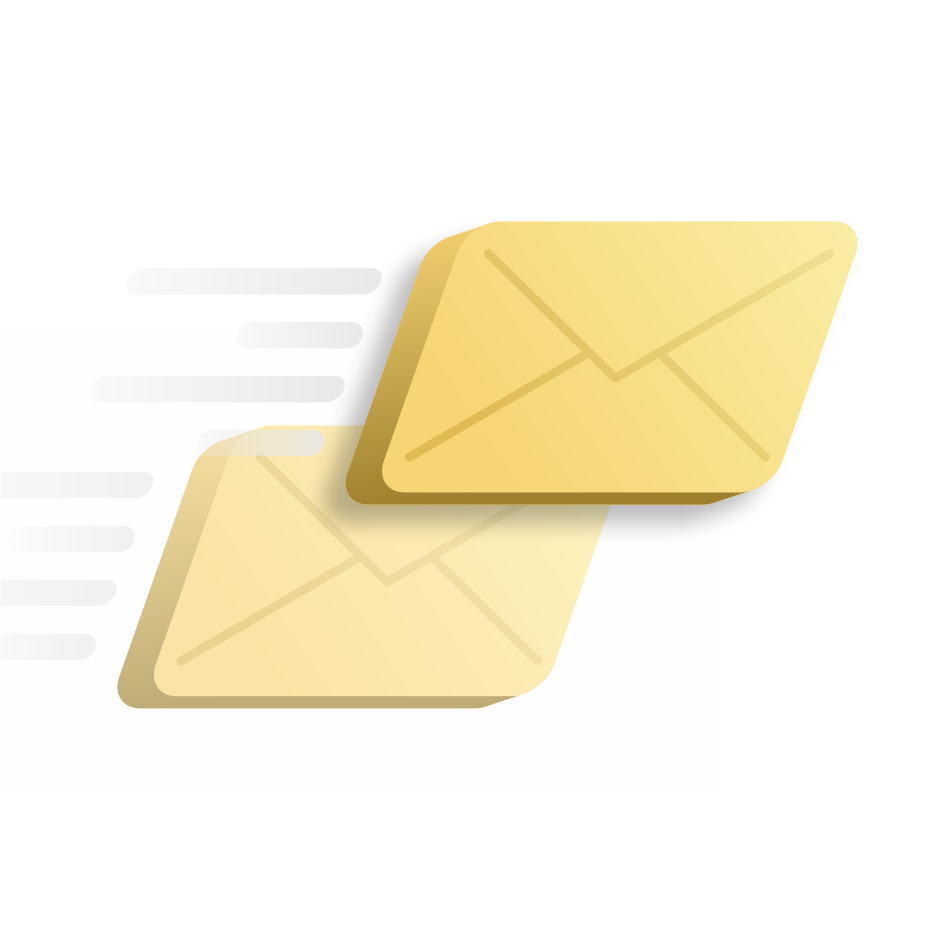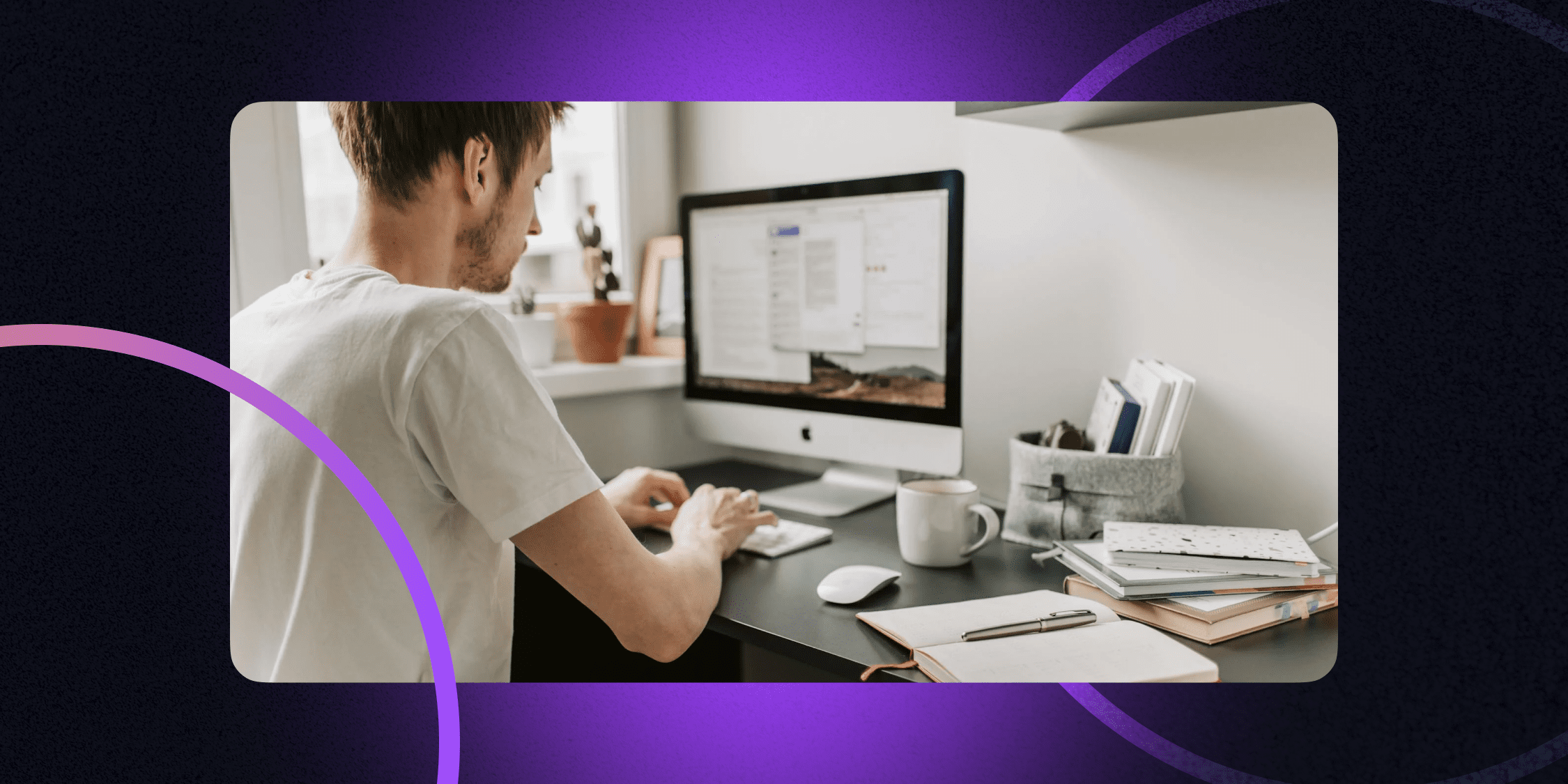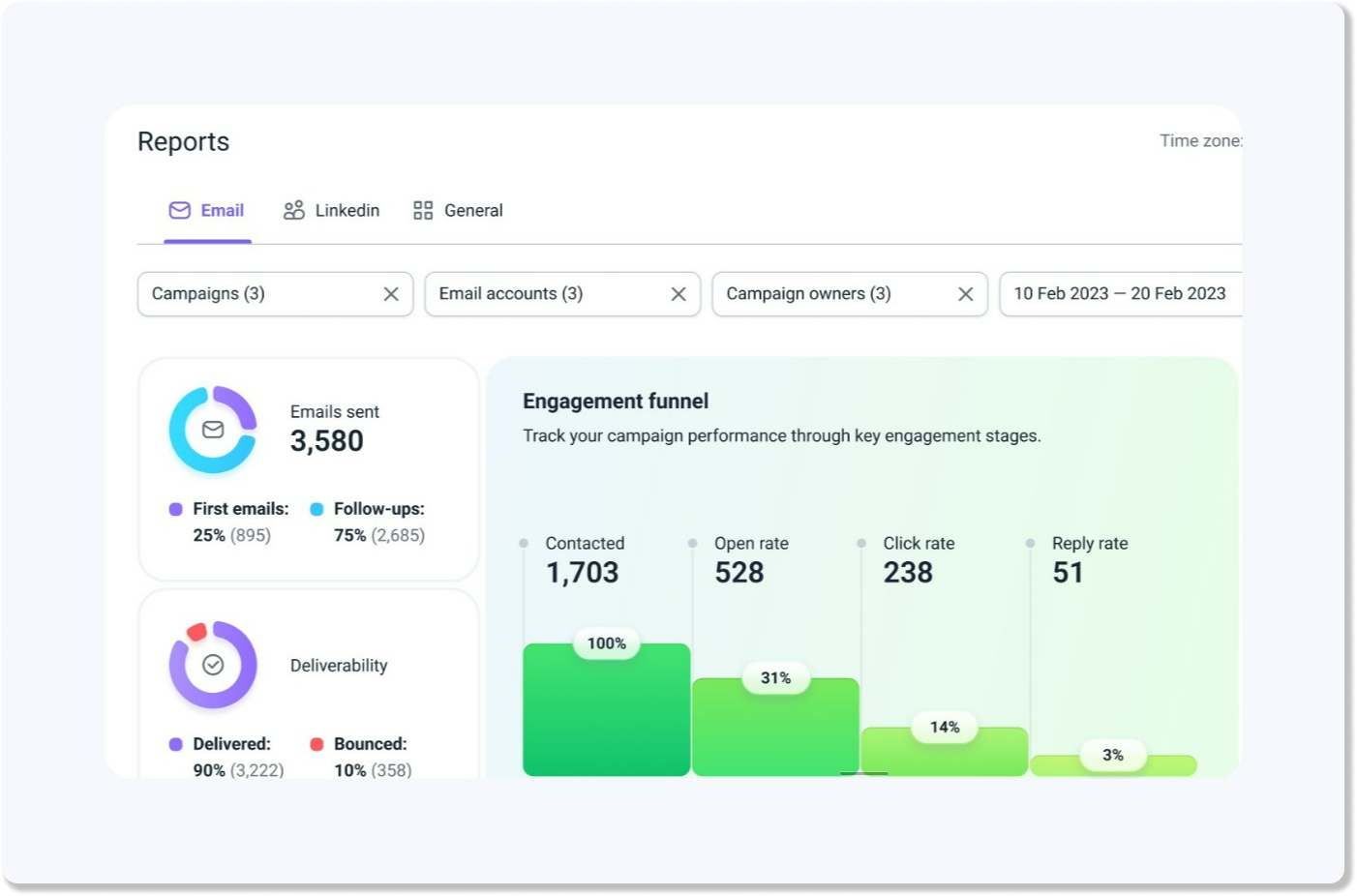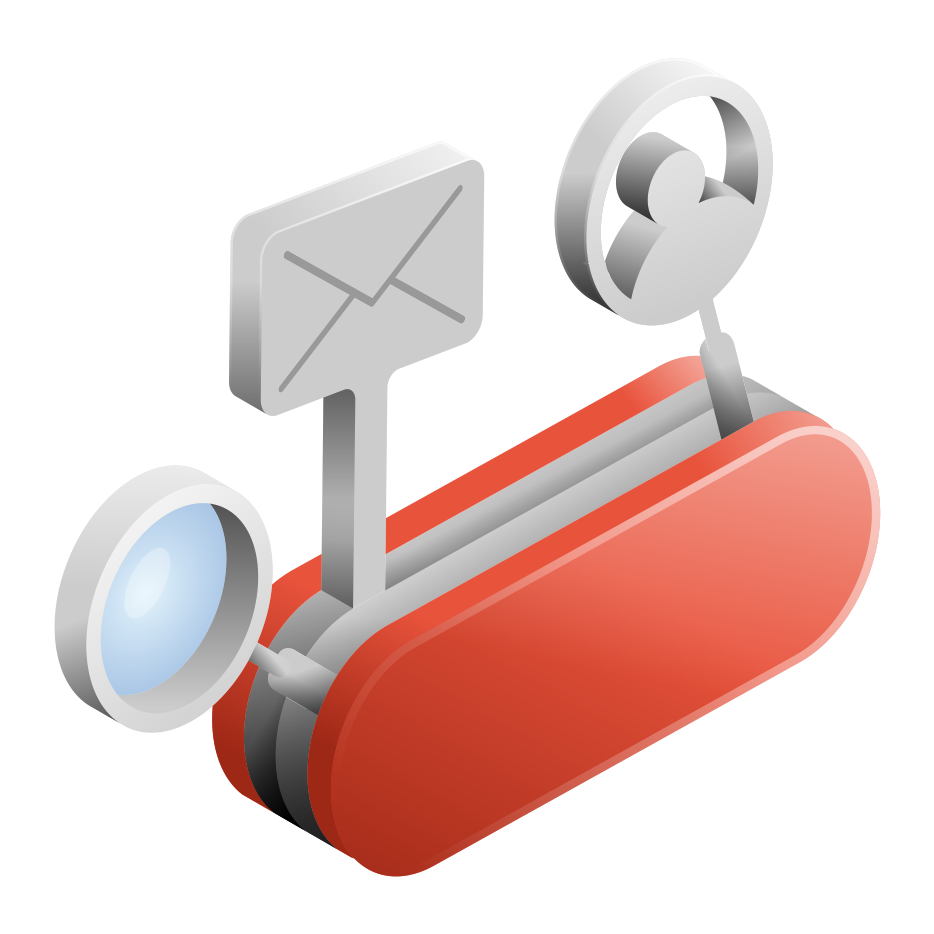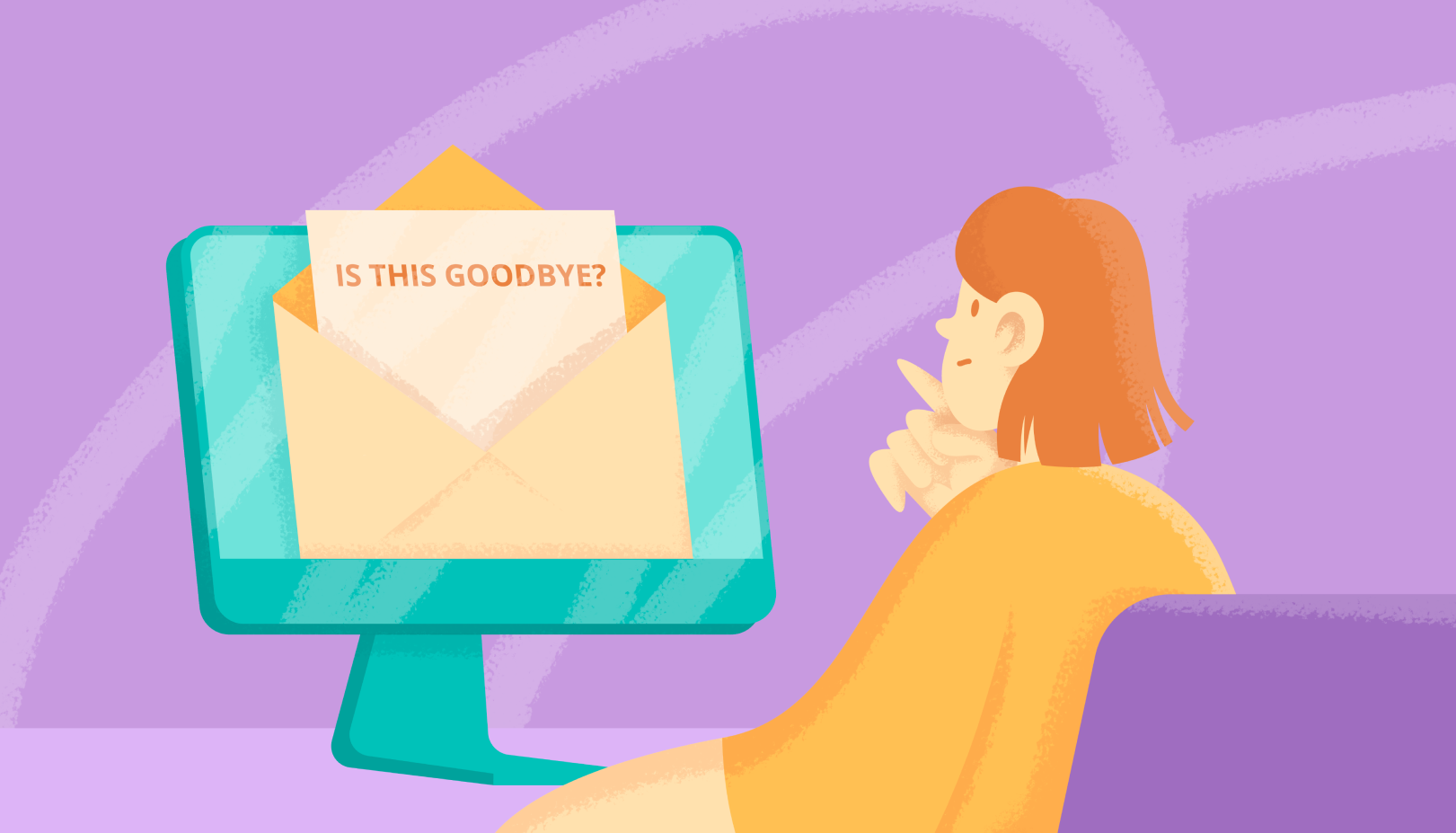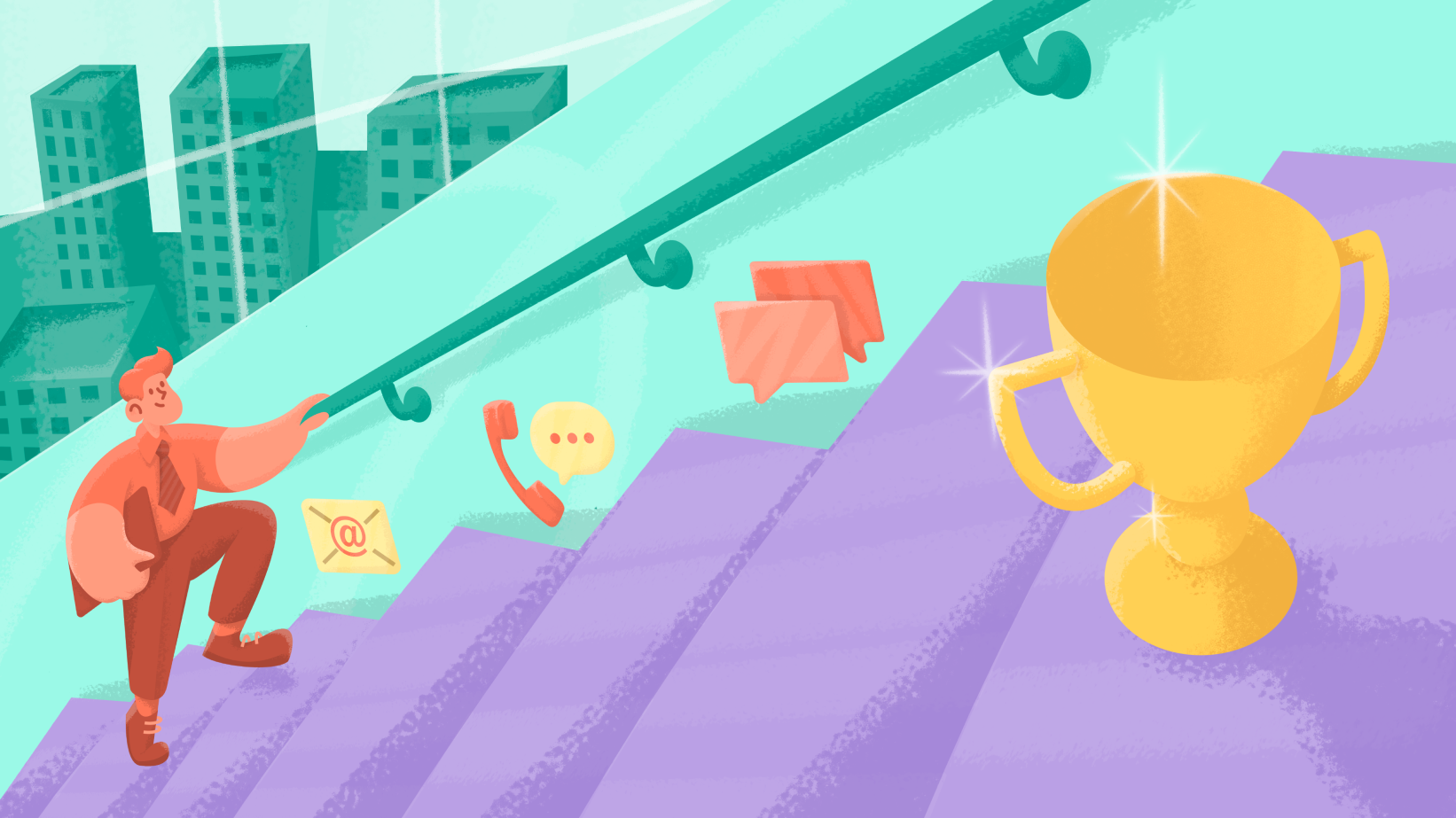Email marketing is a powerful tool, allowing businesses to reach their audience directly and personally. However, the success of your marketing efforts hinges on one critical factor: email cadence.
Understanding and optimizing your email marketing frequency can significantly enhance engagement, improve customer relationships, and drive business growth.
In this article, we’ll delve into the concept of email cadence, explore its benefits, and offer guidance on determining the right email frequency for your business.
Let’s dive in!
Outline
What is email cadence?
Email cadence refers to the rhythm, timing, and frequency with which emails are sent to subscribers. It’s about finding the right balance between keeping your audience engaged and not overwhelming them with too many emails.
Email cadence frequency varies from business to business and can depend on factors such as industry, target audience, and the nature of the content being shared.
Cadence meaning in business
In the broader business context, cadence refers to the consistent flow of activities and communications within a company or organization. It’s about setting a regular pace that meets your audience’s expectations.
Just like in email marketing, finding the right frequency in business communications can lead to better engagement, trust, and overall satisfaction.
For instance, in sales, a well-planned marketing cadence ensures that follow-ups are timely and persistent without being intrusive. In internal communications, a steady rhythm keeps employees informed and engaged without overwhelming them with information.
Benefits of finding the right email cadence
Finding the right email marketing frequency offers several benefits that can elevate your marketing strategy and contribute to your business’s success. Here are some of the key advantages:
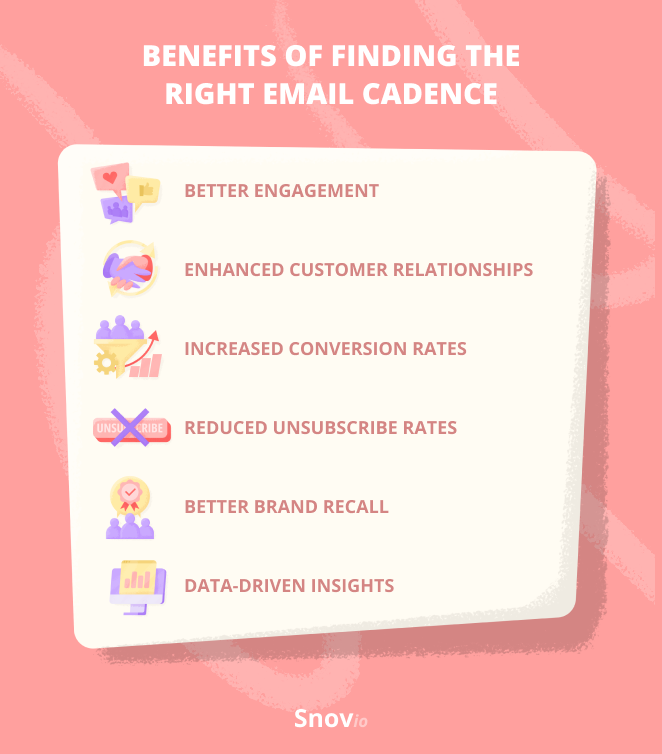
1. Better engagement
When emails are sent at the right frequency, subscribers are more likely to open, read, and engage with the content. Too many messages can lead to fatigue and unsubscribes, while too few can result in lost interest.
2. Enhanced customer relationships
A well-planned cadence helps build trust and strengthen relationships with your audience. Consistent, valuable content shows that you understand their needs and respect their time.
3. Increased conversion rates
By sending messages at optimal intervals, you can better nurture prospects through the sales funnel, ultimately leading to higher conversion rates.
Expert opinion:
Signing up is a powerful signal of intent to buy. Send them an email until they do.
MarTech Advisor, Founder, and Chief of Email vendor selection
4. Reduced unsubscribe rates
Finding the right balance in email frequency reduces the risk of subscribers feeling overwhelmed and choosing to opt out of your emailing list and leads to more satisfied customers.
5. Better brand recall
Regular, thoughtfully timed emails keep your brand at the top of your audience’s mind. This increases the likelihood that they’ll think of your brand when they need your products or services.
6. Data-driven insights
Monitoring and adjusting your email frequency based on performance metrics allows you to gather valuable insights about your audience’s preferences and behaviors, leading to more effective campaigns.
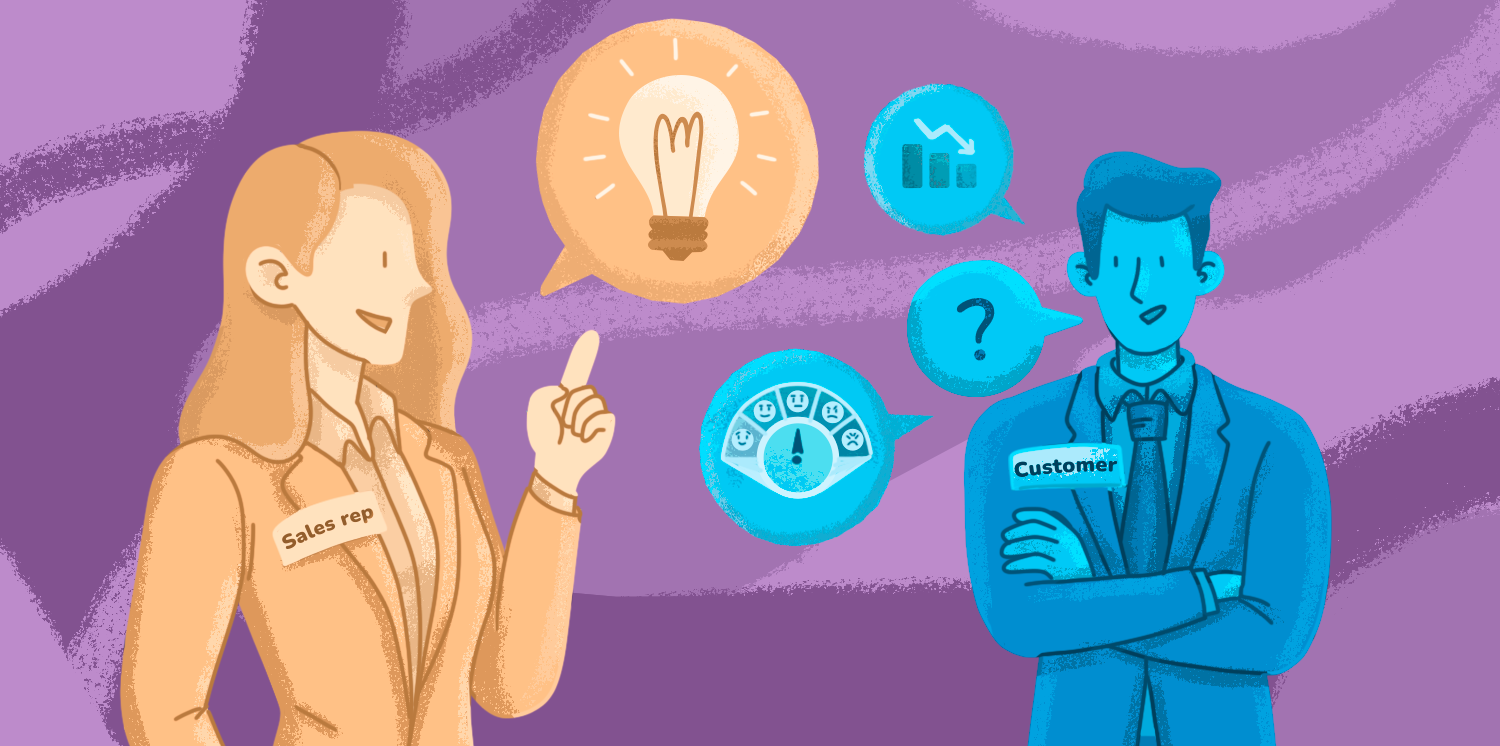
How to determine your ideal email cadence
Establishing the ideal email cadence frequency for your business involves a combination of understanding your audience, analyzing data, and continuous testing. Here are some steps to help you find the right balance:
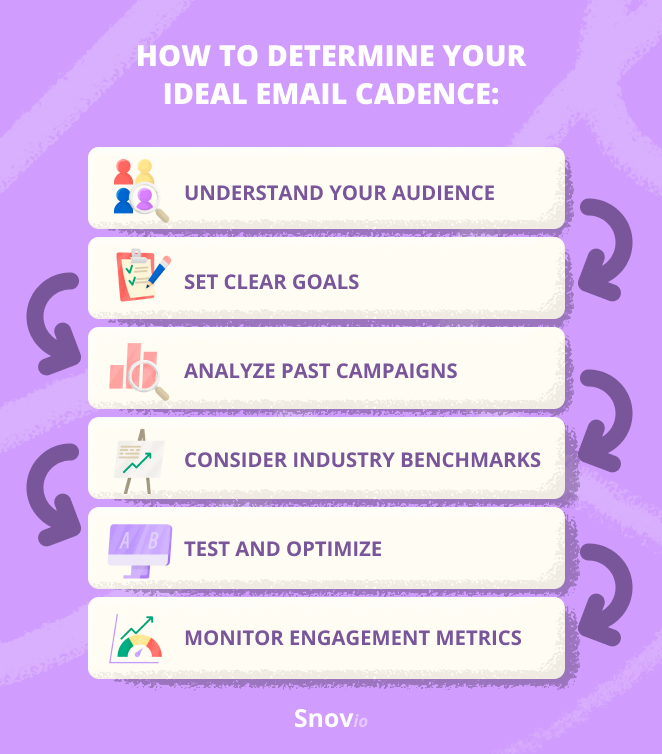
1. Understand your audience
Start by segmenting your audience based on factors such as demographics, purchase history, and engagement levels. Different segments may respond better to different frequencies.
For example, new subscribers might appreciate more frequent emails initially, while long-term subscribers may prefer less frequent updates.
2. Set clear goals
Define your email marketing objectives. Are you looking to drive sales, increase brand awareness, or nurture leads? Your goals will influence the frequency and content of your emails.
3. Analyze past campaigns
Look at the performance of your previous email outreach campaigns. Identify patterns in open rates, click-through rates, and unsubscribe rates relative to the frequency of your emails. This historical data can provide insights into what marketing cadence works best for your audience.
4. Consider industry benchmarks
While it’s essential to tailor your cadence to your specific audience, industry benchmarks can provide a useful reference point. Research what works well for similar businesses and use that information to inform your strategy.
5. Test and optimize
Perform A/B testing to experiment with different email frequencies. Split your audience into groups and send emails at varying intervals. Analyze the results to determine which frequency yields the best engagement.
6. Monitor engagement metrics
Continuously track key metrics such as open rates, click-through rates, conversion rates, and unsubscribe rates. Use these metrics to adjust your email frequency and improve your strategy.
|
Expert tip from Snov.io: Tracking your campaign results helps you gain insights into what resonates with your audience, optimize engagement, and drive higher conversion rates. In other words, this is a valuable tool in creating the perfect email cadence. With Snov.io’s cold email software, you can get detailed information on your campaign performance, including but not limited to:
And much more!
|
Email cadence best practices and examples
To help you develop an effective mail rhythm, here are some best practices and email cadence examples to consider:
1. Welcome series
When someone subscribes to your mailing list, send a series of welcome messages over a week or two. Introduce your brand, share valuable content, and offer incentives such as discounts or free resources.
For example, send a welcome letter immediately upon sign-up, a follow-up letter two days later with more information about your offerings, and a final message a week later with a special offer.
2. Regular newsletters
Maintain a consistent schedule for your newsletters. Whether it’s weekly, bi-weekly, or monthly, ensure that your audience knows when to expect your updates.
For instance, a monthly newsletter might include company news, industry insights, and featured products or services.
3. Promotional campaigns
Plan your promotional mail around key dates and events relevant to your business and audience. Avoid bombarding your subscribers with too many promotional emails in a short period.
For instance, if you’re running a holiday sale, send a teaser message a week before, a reminder email a few days before, and a final call-to-action message on the day of the sale.
Be mindful of the amounts of promos you send your subscribers if you don’t want them to get overwhelmed and mark your emails as spam.
Expert opinion:
Email marketing is like a first date. If you’re too pushy, you won’t get a second one.
Co-Founder at Neil Patel Digital
4. Behavior-triggered emails
Use automation to send letters based on specific actions taken by your subscribers. If a customer abandons their shopping cart, send a reminder message within 24 hours, followed by a second email with a discount offer if they don’t complete the purchase.
5. Re-engagement campaigns
Identify inactive subscribers and try to re-engage them with a targeted campaign. Send a series of emails over a few weeks offering special incentives, asking for feedback, or reminding them of the benefits of staying subscribed.
6. Personalized content
Tailor your cadence, email content, and triggers (conditions) based on individual subscriber preferences and behaviors.
For example, if a subscriber frequently opens and clicks on emails related to a specific product category, send them more similar content at a frequency they seem comfortable with.
Why Snov.io is a great tool to optimize your email cadence
Snov.io is a comprehensive sales engagement and automation platform that can significantly enhance your ability to improve email marketing frequency. Here are several reasons why Snov.io stands out as an excellent tool for this purpose:
1. Advanced cold email tool
Snov.io allows you to create sophisticated cold email software, ensuring your messages are sent at optimal times based on user interactions and behaviors. This helps maintain a consistent and effective cadence that aligns with your audience’s engagement patterns.
2. Multichannel outreach
Implementing various outreach channels into your cadence helps you reach a broader audience and double the chances of closing deals successfully.
Snov.io offers powerful LinkedIn outreach automation that allows you to add automated LinkedIn actions to your email campaigns. For example, you can set up a multichannel campaign with emails, LinkedIn profile views, personalized connection requests, messages, and InMails.
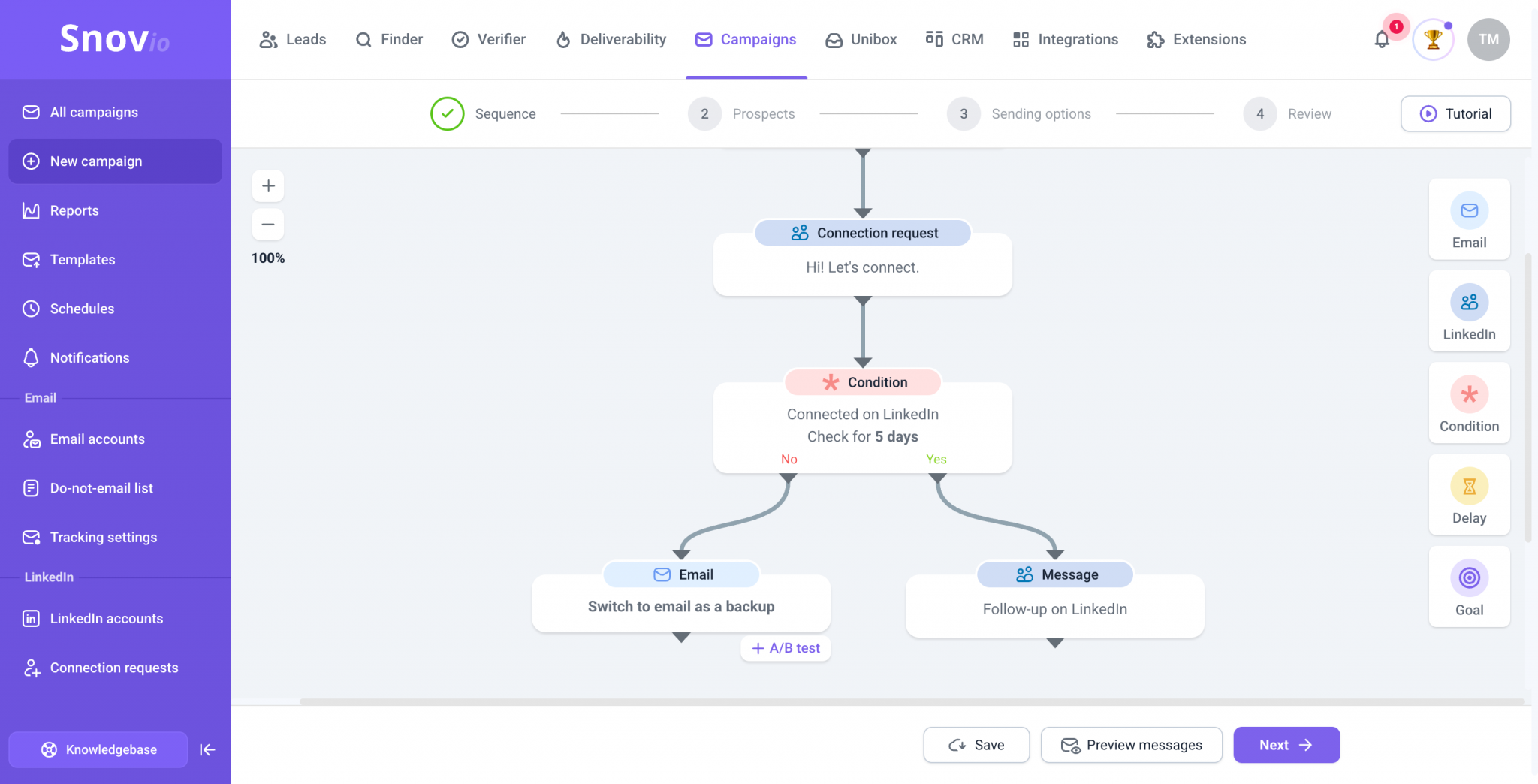
The platform’s powerful automation capabilities enable you to set up personalized email sequences that automatically adjust the frequency and timing based on conditions such as opens, clicks, and responses. This dynamic adjustment helps in maintaining an optimal frequency without manual intervention.
3. Segmentation and targeting
Snov.io provides advanced segmentation features that allow you to categorize your email list based on various criteria, such as user behavior, demographics, and engagement levels. This ensures that each segment receives emails at a frequency that suits their preferences, leading to higher engagement and lower unsubscribe rates.
4. A/B testing
Snov.io supports A/B testing, enabling you to experiment with different message frequencies and timings to identify the most effective cadence. By comparing the results of these tests, you can determine the best approach for engaging your audience.
5. Unibox for managing email communication
This Snov.io feature helps you keep all email conversations in one place. You can connect multiple accounts, switch between email clients, but still view all email messages on a single dashboard. The Unibox enables your team to stay aligned, receive real-time updates on your email cadences, and join conversations when needed.
6. Integration capabilities
Snov.io integrates seamlessly with various CRM systems and other marketing tools, allowing you to leverage existing data to inform your strategy. This integration ensures that your email cadence marketing efforts are cohesive and aligned with your overall marketing goals.
7. User-friendly interface
The platform’s intuitive and user-friendly interface makes it easy to set up and manage email campaigns. Even if you’re not a tech-savvy marketer, Snov.io provides the tools and support needed to optimize your cadence effectively.
Other tools to optimize your email cadence
Several tools can help you optimize your message cadence and streamline your marketing efforts. Here are some popular options:
1. Email marketing platforms
Platforms like Mailchimp, Constant Contact, etc. offer robust email campaign management features, including automation, segmentation, and analytics. These tools can help you design, schedule, and analyze your messages to find the optimal frequency.
2. Customer relationship management (CRM) systems
CRMs like Salesforce, Snov.io CRM, HubSpot, and Zoho CRM, offer tools for creating, sending, and tracking email campaigns. They often include features like automation, segmentation, and analytics to optimize your cadence.
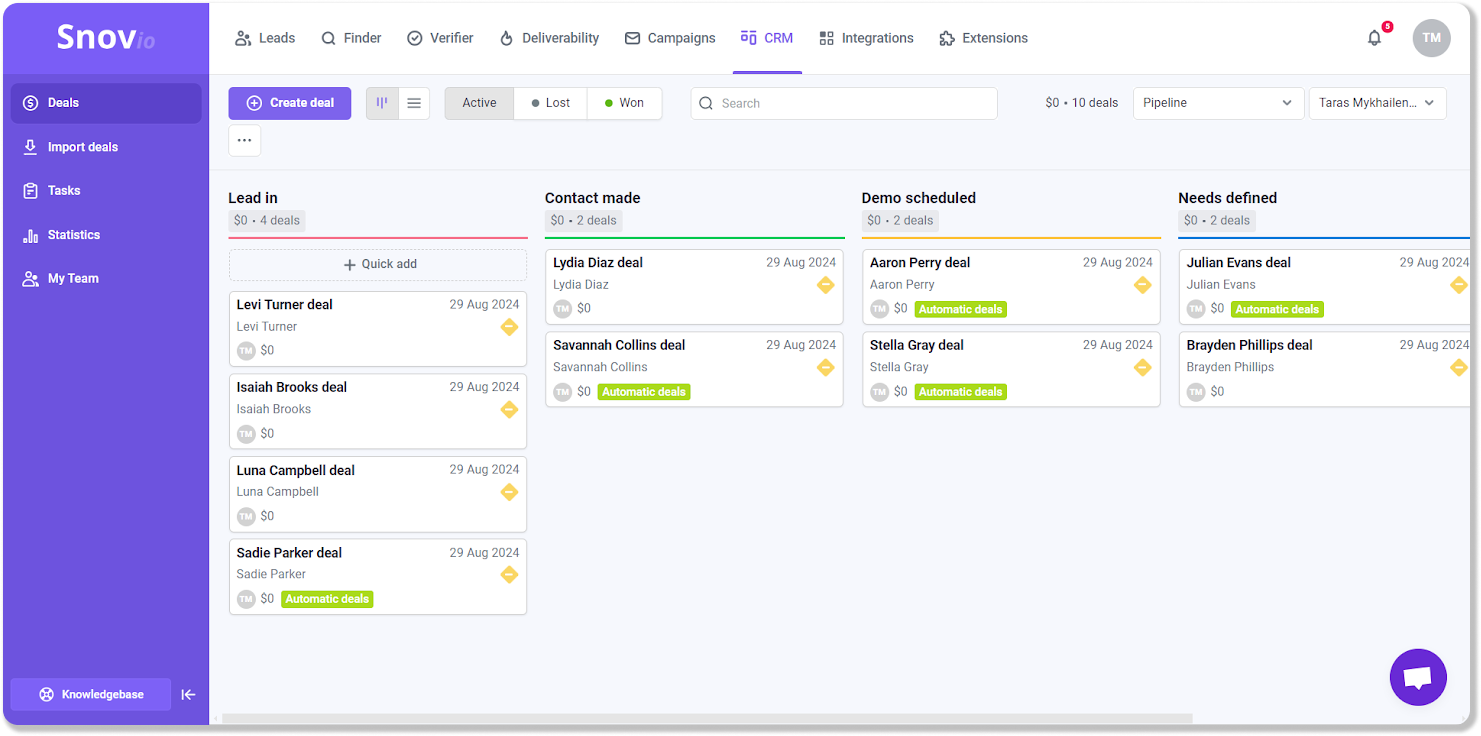
3. Calendar Management Tools
By integrating with your email marketing platform, calendar tools like Google Calendar or Outlook Calendar can help you schedule sends, track email performance, and avoid conflicts with other appointments.
4. Analytics tools
Google Analytics, SumoMe, and other analytics platforms can track the performance of your email campaigns and provide detailed reports on metrics such as open rates, click-through rates, and conversion rates. Use this data to refine your mail frequency.
5. Automation tools
Automation platforms like ActiveCampaign and Snov.io let you set up complex email workflows based on subscriber actions and behaviors. Automating your cadence ensures timely and relevant communications without manual intervention.
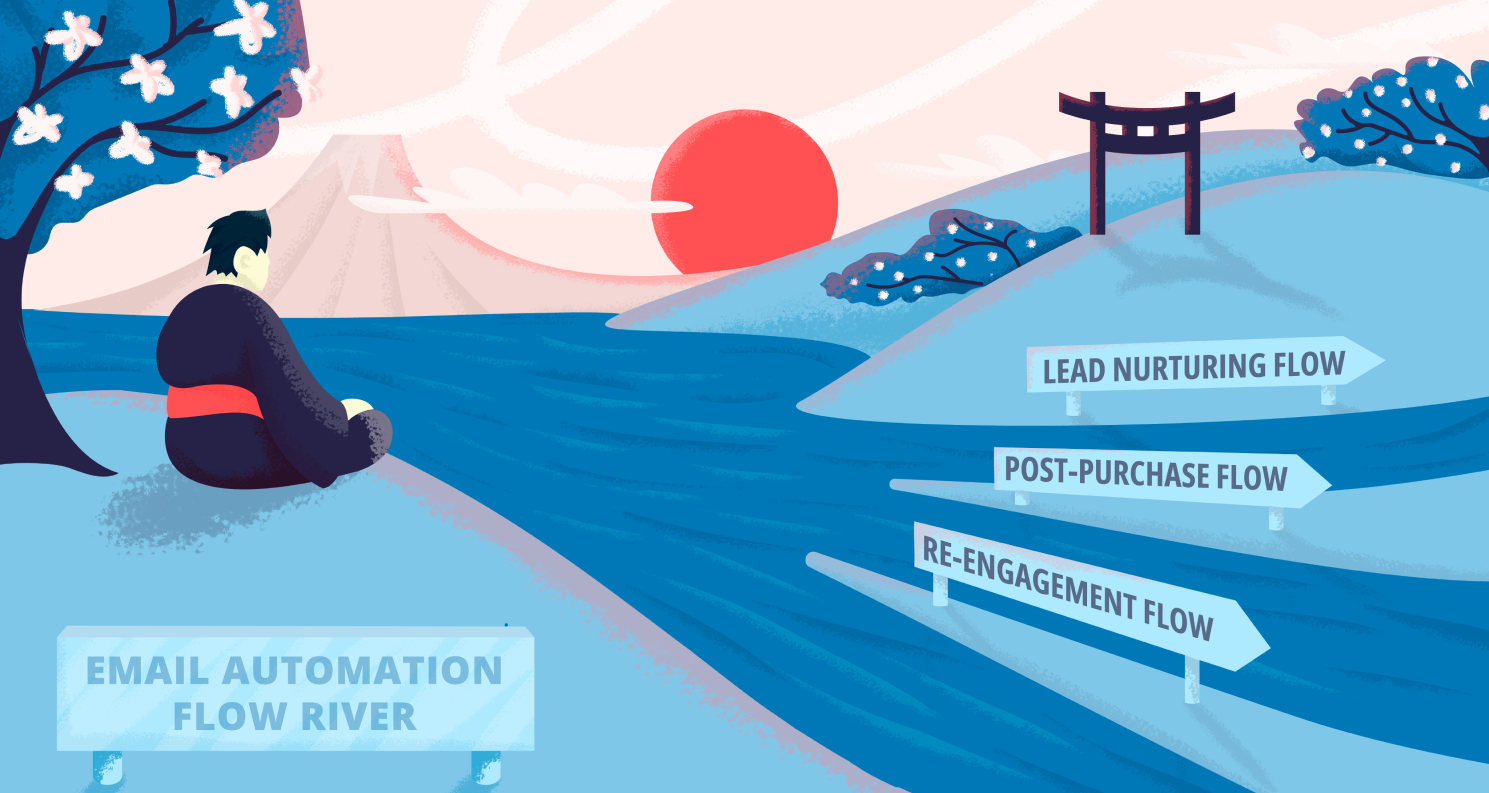
Email Automation Workflows: Best Practices & Examples
April 30 2025
6. Feedback tools
Use survey tools like SurveyMonkey or Typeform to gather feedback from your subscribers about your email frequency and content. Direct input from your audience can help you adjust your cadence to meet their needs and preferences better.
Key takeaways
As you see, mastering email cadence is crucial for optimizing your email marketing strategy. By understanding the concept, recognizing its benefits, and following best practices, you can create a cadence that keeps your audience engaged and drives your business forward.
Utilize tools like Snov.io to continuously monitor, test, and refine your approach, ensuring that your emails hit the right notes at the right times.
With a thoughtful and data-driven marketing cadence, you’ll build stronger customer relationships, enhance brand loyalty, and achieve your marketing goals.

